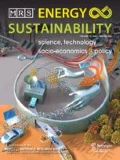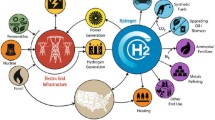Abstract
Sustainable, carbon-free methods of large-scale hydrogen production are urgently needed to support industrial processes while decreasing carbon dioxide emissions. The realities of product development timelines dictate that existing commercial technologies such as low-temperature electrolysis will have to serve the majority of this need for at least the next 20 years. At the same time, even a cursory understanding of device design principles and real-world constraints can help to inform basic research. Accelerating the impact from fundamental material discoveries in related technologies therefore requires improved collaboration between academic, government, and industry sectors.
Renewable hydrogen is a key component to global decarbonization and reduction in carbon dioxide emissions. A common misconception is that the need for greener sources of hydrogen is dependent on whether fuel cell vehicles significantly penetrate the automotive market. However, hydrogen is a critical feedstock for many industrial processes, with an annual demand of 65 million metric tons globally. The large majority of this hydrogen is made via steam methane reforming, which represents the major carbon dioxide contribution for industrial processes such as ammonia production. Sustainable manufacturing of hydrocarbons also requires a sustainable source of hydrogen. Deep decarbonization and meeting 80% reduction targets for carbon dioxide emissions thus requires carbon-free sources of hydrogen. Based on the technology readiness levels, the reality is that existing commercial technologies will dominate the market for the next 20 years and beyond. To accelerate the impact of fundamental work in long-term technologies, improved collaboration between researchers across academic, government, and industry sectors is essential, to inform basic research as well as to leverage technology breakthroughs in the near term.









Similar content being viewed by others
References
Pivovar B.: H2 at scale: Enhance the U.S. energy portfolio through sustainable use of domestic resources, improvements in infrastructure, and increase in grid resiliency (Fuel Cell Technologies Office H2@Scale Workshop, November 16, 2016). Available at: https://energy.gov/sites/prod/files/2016/12/f34/fcto_h2atscale_workshop_pivovar_2.pdf (accessed June 29, 2017).
Satyapal S.: U.S. Department of Energy Hydrogen and Fuel Cells Program (2017 Annual Merit Review and Peer Evaluation Meeting). Available at: https://energy.gov/sites/prod/files/2017/06/f34/01_satyapal_ plenary_2017_amr.pdf (accessed August 4, 2017).
Fuel Cell Technologies Office hydrogen production fact sheet. Available at: https://energy.gov/sites/prod/files/2016/07/f33/fcto_hydrogen_ production_fs.pdf (accessed June 29, 2017).
Hydrogen production and distribution (IEA Energy Technology Essentials, April 2007). Available at: http://www.iea.org/publications/freepublications/publication/essentials5.pdf (accessed June 29, 2017).
Strategic Energy Technologies Information System: Energy efficiency and CO2 reduction in the iron and steel industry. Available at: https://setis.ec.europa.eu/system/files/Technology_Information_Sheet_Energy_ Efficiency_and_CO2_Reduction_in_the_Iron_and_Steel_Industry.pdf (accessed June 29, 2017).
Roadmap for the establishment of a well-functioning EU hydrogen GO system (October 21, 2016). Available at: http://www.certifhy.eu/images/ media/files/D5_1_Implementation_Roadmap-v15-final.pdf (accessed August 3, 2017).
California Air Resources Board (ARB): Low carbon fuel standard video. Available at: https://www.arb.ca.gov/fuels/lcfs/lcfs.htm (accessed June 29, 2017).
Pivovar B.: H2 at scale: Energy system-wide benefits of increased H2 implementation (Department of Energy Hydrogen and Fuel Cell Technical Advisory Committee Meeting, May 4-5, 2016). Available at: https://www.hydrogen.energy.gov/pdfs/htac_may17_04_pivovar.pdf (accessed June 29, 2017).
Sarkar R. and Satyapal S.: H2@scale overview (Fuel Cell Technologies Office H2@Scale Workshop, November 16, 2016). Available at: https://energy.gov/sites/prod/files/2016/12/f34/ fcto_h2atscale_workshop_sarkar_satyapal_2.pdf (accessed June 29, 2017).
Stolten D.: The potential role of hydrogen technology for future mobility. How can this improve our life? (October 2014). Available at: https://www.researchgate.net/publication/270959313_The_Potential_Role_of_ Hydrogen_Technology_for_Future_Mobility_How_Can_this_Improve_ Our_Life (accessed August 3, 2017). doi: 10.13140/2.1.3473.6969.
Nied D.: The long road to the Mirai (Toyota Today, Jan/Feb 2015). Available at: http://toyotatoday.com/news/hydrogen-fuel-cell-timeline. htm (accessed June 30, 2017).
Kurtz J., Sprik S., Ainscough C., and Saur G.: Fuel cell electric vehicle evaluation (DOE 2015 Annual Merit Review). Available at: http://www.nrel.gov/docs/fy15osti/64221.pdf (accessed June 30, 2017).
Danilovic N., Ayers K.E., Capuano C.B., Renner J.N., Wiles L., and Pertoso M.: Challenges in going from laboratory to megawatt scale PEM electrolysis. ECS Trans. 75, 395 (2016).
Department of Energy Fuel Cell Technologies Office Multi-Year Research, Development, and Deployment Plan. Available at https://energy.gov/eere/ fuelcells/downloads/fuel-cell-technologies-office-multi-year-researchdevelopment- and-22 (accessed June 30, 2017).
Acknowledgments
The author gratefully acknowledges Dr. Bryan Pivovar for valuable discussions. The author also acknowledges ARPA-E grant DE-AR0000688 for MRS conference travel at which the original talk was presented.
Author information
Authors and Affiliations
Corresponding author
Rights and permissions
About this article
Cite this article
Ayers, K. Gigawatt-scale renewable hydrogen via water splitting as a case study for collaboration: The need to connect fundamental and applied research to accelerate solutions. MRS Energy & Sustainability 4, 11 (2017). https://doi.org/10.1557/mre.2017.13
Received:
Accepted:
Published:
DOI: https://doi.org/10.1557/mre.2017.13



